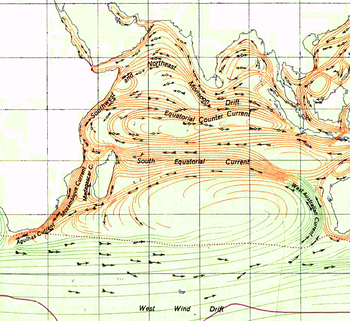Agulhas current

The Agulhas Current is a sea current in the south-western Indian Ocean . It flows south along the east coast of Africa (from around 27 ° S to 40 ° S) and transports enormous amounts of heat and salt to the south.
The sources of the Agulhas Current are the East Madagascar Current , the Mozambique Current and parts of the recirculating water, part of which is the Agulhas Current itself. The Agulhas Current is highly dependent on the topography, especially north of Port Elizabeth (South Africa) it flows closely along the continental slope . The transport of the fully formed Agulhas Current is around 65–70 million m³ / s = 65–70 Sverdrup . However, this is controversial in primary science.
South of Cape Agulhas (the southern tip of the African continent) it penetrates some 100 km into the Atlantic before it makes an abrupt U-turn and flows back into the Indian Ocean as the Agulhas return current . On the coast it extends to the Cape of Good Hope . The physics of this retroflexion has not been fully investigated, but the probable causes are to be found in the soil topography, the coastline of Africa and above all the vorticity balance of the current (in connection with the wind field).
The retroflexion is not complete and the amount of warm and salty water flowing into the Atlantic has increased in recent decades due to global warming. A study carried out by the University of Miami examined the effects of a further increasing inflow with the help of climate simulations; it was found that this would increase the thermohaline circulation . While it was assumed in the IPCC's AR4 published in 2007 that global warming due to increased flow of meltwater will weaken the warming in Europe, the opposite could happen with the process described. Instead of a weakening of the thermohaline circulation, which would cool the northern hemisphere, a warming would take place that would superimpose and intensify the global warming trend.
At the retroflexion, the Agulhas Current forms agulhas rings at intervals of about 2–3 months, which migrate into the South Atlantic and are carried there ( advehed ) to the northwest by the central current (the South Equatorial Current ). Agulhas rings transport the warm and salty water of the Indian Ocean to the north and thus form part of the global thermohaline circulation. Agulhas rings are among the most powerful eddies in the world ocean.
See also
literature
- JRE Lutjeharms: The Agulhas Current. Springer, Berlin 2006, ISBN 3-540-42392-3 .
- WPM De Ruijter, A. Biastoch, SS Drijfhout, JRE Lutjeharms, R. Matano, T. Pichevin, PJ Van Leeuwen, W. Weijer: Indian-Atlantic inter-ocean exchange: Dynamics, estimation and impact. In: J. Geophys. Res. 104, 1999, ISSN 0148-0227 , pp. 20885-20910.
- L. Stramma , JRE Lutjeharms: The flow field of the subtropical gyre of the South Indian Ocean. In: J. Geophys. Res. 102, 1997, ISSN 0094-8276 , pp. 5513-5530.
Web links
- Agulhas current (English)
- IFM-Geomar (modeling of the Agulhas current)
Individual evidence
- ↑ Wissenschaft-Online (Article - Infusion for the Atlantic)
- ↑ Threading the Climate Needle: The Agulhas Current System Increased Agulhas "leakage" significant player in global climate variability Press release of the National Science Foundation 4/2011
